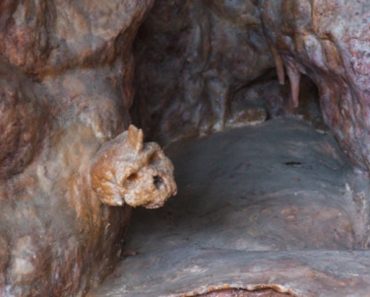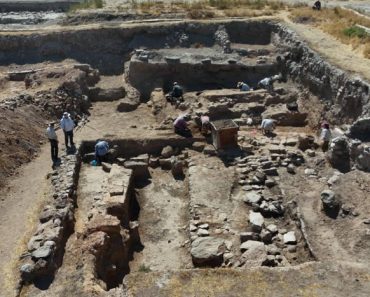A remarkable 2,000-year-old Roman stele featuring an intricately carved eagle clutching a wreath has been discovered in the ancient city of Manbij, Syria. The black basalt funerary monument, adorned with Greek inscriptions, offers a rare glimpse into Roman imperial symbolism and the complex cultural heritage of northern Syria during antiquity.
The discovery began when a local resident noticed the heavy stone behind the cardamom wholesale market in Manbij, east of Aleppo. Recognizing its potential significance, the individual immediately contacted Syria’s Directorate of Museums and Antiquities reports Arkeonews. Archaeological teams swiftly secured the artifact and transferred it to the old bathhouse site in Manbij for safekeeping before its planned relocation to Aleppo for comprehensive analysis.
Removal of the Roman basalt stele from the find site in Syria. (Directorate of Archaeology and Museums Syria)
Imperial Symbolism in Stone
The eagle’s prominence on this stele reflects the profound symbolic weight this magnificent bird carried throughout the Roman Empire. In Roman culture, the eagle represented divine authority, military prowess, and eternal life. As the sacred bird of Jupiter, king of the Roman gods, eagles frequently adorned military standards, imperial monuments, and funerary markers across the empire’s vast territories.
The carved eagle on this Manbij stele displays outstretched wings while grasping a wreath – a powerful symbol combining imperial authority with victory and remembrance. Such imagery was particularly meaningful on funerary monuments, where the eagle’s association with divine protection and the soul’s journey to the afterlife provided comfort to the bereaved and honored the deceased.

Funerary relief with an eagle in an oaken wreath from ancient Rome. (Sailko/CC BY 3.0)
Greek Inscriptions Bridge Cultures
The presence of Greek text on this Roman-era stele highlights the sophisticated cultural fusion that characterized the eastern provinces of the empire. Greek served as the lingua franca throughout much of the eastern Mediterranean, and Roman administrators frequently employed Greek for official inscriptions, particularly in regions with established Hellenistic traditions.
These inscriptions likely contain vital information about the deceased individual, possibly including their name, family connections, social status, or military achievements. Once fully translated, the text may reveal details about the social dynamics of Roman-era Manbij and the individuals who called this strategic city home during the height of imperial power explains Archaeology Magazine.

Roman basalt stele being cleaned on site. (Directorate of Archaeology and Museums Syria)
Manbij’s Ancient Legacy Under Threat
Historically known as Hierapolis Bambyce, Manbij flourished as a significant religious and commercial center in northern Syria. The city gained particular renown for its temple dedicated to Atargatis, the Syrian fertility goddess, which attracted pilgrims from across the ancient world. Under Roman rule, Manbij maintained its importance as a regional administrative center and trade hub.
However, Syria’s devastating civil war has posed unprecedented threats to the nation’s archaeological treasures. The Directorate-General of Antiquities and Museums estimates that approximately one million artifacts were looted between 2011 and 2019, while more than 700 archaeological sites sustained severe damage, notes Heritage Daily.
Manbij itself became a focal point for antiquities trafficking during the conflict. Under various controlling factions, organized looting networks systematically stripped the city of its archaeological heritage. The Syrian Democratic Forces’ capture of the city in 2016 brought some stability, but illegal excavation and smuggling operations continued under different management structures.

Roman Emperors Running the Family Business Interview, from the Ancient Origins Store.
Community Vigilance Saves Heritage
The successful recovery of this eagle stele demonstrates how community awareness can protect cultural patrimony even amid ongoing instability. Local residents’ willingness to report archaeological discoveries rather than pursue illicit profit represents a crucial factor in preserving Syria’s heritage for future generations.
This discovery adds to the growing body of evidence documenting Roman cultural influence throughout northern Syria. The stele’s eagle motif, Greek inscriptions, and craftsmanship quality reflect the sophisticated artistic traditions that flourished under Roman administration. As scholars continue analyzing this remarkable artifact, it promises to enhance understanding of ancient Syrian civilization and the enduring power of imperial symbols across diverse cultural landscapes.
The eagle stele now awaits detailed examination in Aleppo, where researchers hope to unlock the secrets held within its ancient Greek text and contribute to the broader narrative of Roman Syria’s rich archaeological legacy.
Top image: Black basalt Roman stele with a carved eagle discovered in Manbij, Syria. Source: Directorate of Archaeology and Museums Syria
By Gary Manners








